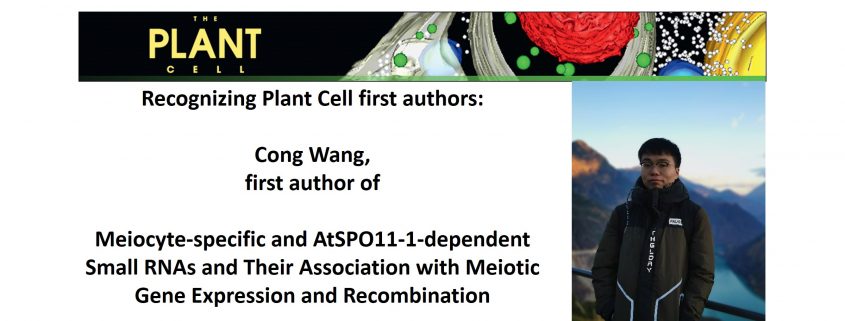Recognizing Plant Cell first authors: Cong Wang
Cong Wang, first author of Meiocyte-specific and AtSPO11-1-dependent Small RNAs and Their Association with Meiotic Gene Expression and Recombination
Current Position: Ph.D. Biochemistry and Molecule Biology, Fudan University, China.
Education: B.S. Biological Science, Sep. 2009-Jul. 2013. Lanzhou University, China
Non-scientific Interests: Travelling, reading and movies.
Brief bio: During the last year of my undergraduate student, I had an opportunity to understand meiosis from Dr. Wang and was greatly attracted by meiosis. After graduation, it is my great honor to obtain an offer for pursuing my Ph.D study advised by Drs. Ma and Wang at Fudan University. During my Ph.D study, I was trained in cytobiology, molecular biology, biochemistry, genetics, and transcriptomes. My Ph.D project mainly focuses on two aspects: One is to address regulatory networks of DNA polymerases in meiotic recombination, specifically for DNA polymerase δ (POL δ) required the DNA lagging strand synthesis. We found the catalytic subunit of POL δ is required for normal formation of meiotic interference-sensitive crossovers (Plant Physiology, 2019), suggesting the essential role of DNA lagging strand synthesis in the recombination. The other is to elucidate the epigenetic regulatory mechanisms during meiosis, including small interfering RNAs, histone methylation, and meiotic gene silencing and chromatin condensation. The meiotic small RNA project has led to the discovery the positive correlation between meiocyte-specific small RNA (sRNA) and meiocyte gene expression. We further found that AtSPO11-1-dependent sRNAs are associated with meiotic crossover motifs. Our finding reveals a new landscape of meiotic small RNA and provides new insights into how sRNAs are relate to gene expression in meiocytes and meiotic recombination. Currently, I have just compeled my PH.D defense, and am planning to apply a post-doctoral position as related to epigenetic regulation of plant reproductive development, especially on meiosis.
王聪,“Meiocyte-specific and AtSPO11-1-dependent small RNAs and their association with meiotic gene expression and recombination” 共同第一作者
目前职位: 中国,复旦大学,生物化学与分子生物学专业,博士(2013.09-2019.01)
教育经历: 中国,兰州大学,生物科学专业,理学学士(2009.09-2013.06)
本人简介:
从兰州大学本科毕业后,我很荣幸地加入了复旦大学马红教授和王应祥研究员的团队攻读我的博士学位。在此期间,我接受了细胞生物学、分子生物学、生物化学、遗传学和组学分析等方面的科研训练。在博士研究生涯中,我的科研方向是植物减数分裂,主要工作集中在以下两个方面:
1、DNA合成因子调控减数分裂重组的作用网络,特别是后随链合成在减数分裂重组中的作用。我们运用减数分裂特异的基因沉默技术,分析了DNA后随链合成聚合酶δ(AtPOLD1)在减数分裂重组中的具体功能,结果发现降低POLD1的表达,会影响减数分裂同源染色体联会和重组,产生大量染色体碎片,最终导致植物育性降低。通过进一步对不同重组的类型进行定量,发现POLD1主要影响干涉敏感型重组通路,且其功能可能独立于前导链延伸聚合酶ε。该结果进一步加强了减数分裂重组需要DNA后随链合成因子的观点,完善了DNA合成因子参与减数分裂重组的模型。
2、探究减数分裂过程中的表观遗传调控机制,包括sRNA、组蛋白甲基化、基因沉默和染色质浓缩等。目前,我们通过对减数分裂细胞和体细胞的组学分析发现了2409簇减数分裂细胞特异的ms-sRNA(meiocyte-specific small RNA)集群,而后通过与DSB缺失突变体(spo11-/-)的减数分裂细胞小RNA比较后发现1660个DSB依赖的ms-sRNAs集群。其中ms-sRNA不同于体细胞siRNA主要分布在异染色质区并且抑制转座子和基因的表达,其主要分布在常染色质的基因编码区,且与基因表达正相关。此外,我们还发现DSB依赖的ms-sRNAs富集于重组发生的热区,并和重组偶联的DNA基序显著关联。该工作首次揭示了减数分裂特异小RNA的长度和分布等特征,特别是其与减数分裂表达基因和重组的关系分裂重组相关提供了新的见解。
目前,我刚刚完成博士答辩,还在进行一个关于调控减数分裂基因沉默和染色质浓缩相关机制的研究,当前在撰写文章中,并计划申请博士后职位。




